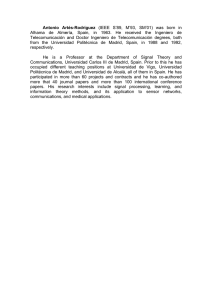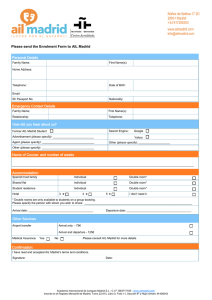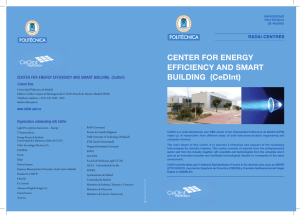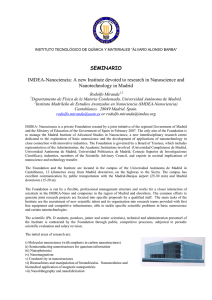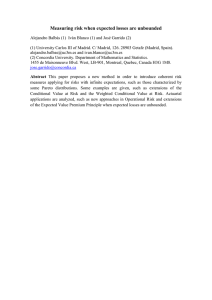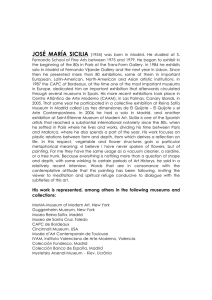In afternoon sessions a paper by Samantha Carrasco (University of
Anuncio
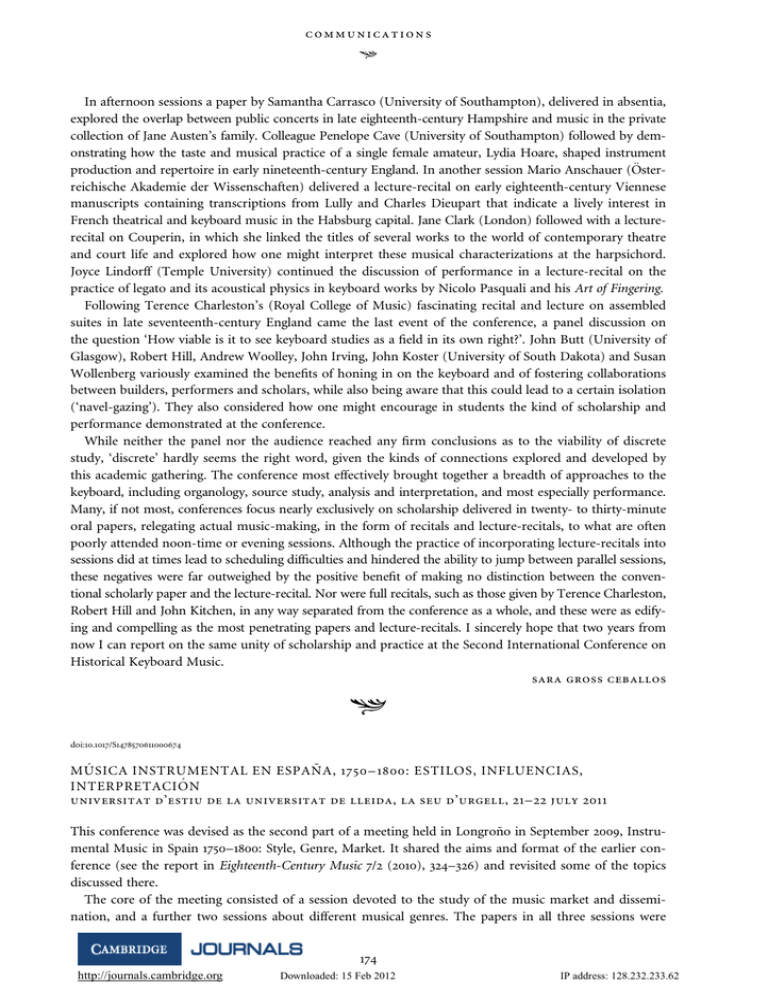
communications In afternoon sessions a paper by Samantha Carrasco (University of Southampton), delivered in absentia, explored the overlap between public concerts in late eighteenth-century Hampshire and music in the private collection of Jane Austen’s family. Colleague Penelope Cave (University of Southampton) followed by demonstrating how the taste and musical practice of a single female amateur, Lydia Hoare, shaped instrument production and repertoire in early nineteenth-century England. In another session Mario Anschauer (Österreichische Akademie der Wissenschaften) delivered a lecture-recital on early eighteenth-century Viennese manuscripts containing transcriptions from Lully and Charles Dieupart that indicate a lively interest in French theatrical and keyboard music in the Habsburg capital. Jane Clark (London) followed with a lecturerecital on Couperin, in which she linked the titles of several works to the world of contemporary theatre and court life and explored how one might interpret these musical characterizations at the harpsichord. Joyce Lindorff (Temple University) continued the discussion of performance in a lecture-recital on the practice of legato and its acoustical physics in keyboard works by Nicolo Pasquali and his Art of Fingering. Following Terence Charleston’s (Royal College of Music) fascinating recital and lecture on assembled suites in late seventeenth-century England came the last event of the conference, a panel discussion on the question ‘How viable is it to see keyboard studies as a field in its own right?’. John Butt (University of Glasgow), Robert Hill, Andrew Woolley, John Irving, John Koster (University of South Dakota) and Susan Wollenberg variously examined the benefits of honing in on the keyboard and of fostering collaborations between builders, performers and scholars, while also being aware that this could lead to a certain isolation (‘navel-gazing’). They also considered how one might encourage in students the kind of scholarship and performance demonstrated at the conference. While neither the panel nor the audience reached any firm conclusions as to the viability of discrete study, ‘discrete’ hardly seems the right word, given the kinds of connections explored and developed by this academic gathering. The conference most effectively brought together a breadth of approaches to the keyboard, including organology, source study, analysis and interpretation, and most especially performance. Many, if not most, conferences focus nearly exclusively on scholarship delivered in twenty- to thirty-minute oral papers, relegating actual music-making, in the form of recitals and lecture-recitals, to what are often poorly attended noon-time or evening sessions. Although the practice of incorporating lecture-recitals into sessions did at times lead to scheduling difficulties and hindered the ability to jump between parallel sessions, these negatives were far outweighed by the positive benefit of making no distinction between the conventional scholarly paper and the lecture-recital. Nor were full recitals, such as those given by Terence Charleston, Robert Hill and John Kitchen, in any way separated from the conference as a whole, and these were as edifying and compelling as the most penetrating papers and lecture-recitals. I sincerely hope that two years from now I can report on the same unity of scholarship and practice at the Second International Conference on Historical Keyboard Music. sara gross ceballos doi:10.1017/S1478570611000674 MÚSICA INSTRUMENTAL EN ESPAÑA, 1750 – 1800: ESTILOS, INFLUENCIAS, INTERPRETACIÓN universitat d’estiu de la universitat de lleida, la seu d’urgell, 21–22 july 2011 This conference was devised as the second part of a meeting held in Longroño in September 2009, Instrumental Music in Spain 1750–1800: Style, Genre, Market. It shared the aims and format of the earlier conference (see the report in Eighteenth-Century Music 7/2 (2010), 324–326) and revisited some of the topics discussed there. The core of the meeting consisted of a session devoted to the study of the music market and dissemination, and a further two sessions about different musical genres. The papers in all three sessions were 174 http://journals.cambridge.org Downloaded: 15 Feb 2012 IP address: 128.232.233.62 communications remarkably consistent: although focusing on a rather limited field (instrumental music in Madrid during the years of Charles IV, prince and king between c1770 and 1802), diversity was assured thanks to the variety of methodological approaches on display. Judith Ortega (Instituto Complutense de Ciencias Musicales) opened the session on music markets and dissemination by exploring the copyists of the Royal Court of Madrid during the second half of the eighteenth century, clarifying the institutional contexts in which these professionals carried out their duties, identifying their handwriting and ultimately documenting a collection of music that was originally larger than the one preserved nowadays at the Royal Library and Archive. Loukia Drosopoulou (University of York) presented a case study within the framework devised by Ortega, as she presented a detailed analysis of several of Boccherini’s copyists from the Royal Court of Madrid, considering sources already preserved in Berlin and Paris previously thought to be autographs. Aiming to support the view, recently reassessed, that Boccherini had close ties to the Spanish Royal Court, she added new evidence derived from codicological study of the sources. José Carlos Gosálvez (Biblioteca Nacional de España) tackled the production of manuscript music for commercial distribution, and its market in late eighteenth-century Madrid. After clarifying some basic categories (such as the concept of the ‘original copy’, which confers equivalent value on every manuscript produced near the composer, both geographically and chronologically) he proposed and illustrated a theoretical model based on three complementary domains: production, distribution and consumption. A clear picture of manuscript music and the market during the second half of the eighteenth century in Madrid emerged from these papers, thus framing the specific questions arising in the subsequent two sessions, which focused on different genres of instrumental music. Taking as their point of departure the striking changes that instrumental music underwent in Spain during the 1770s, five papers analysed the evolution of different genres of chamber music in Madrid until the death of Gaetano Brunetti (1744– 1798). This roughly thirty-year period in Madrid is becoming increasingly well known to scholars, presenting a historical picture that is in some respects similar to that in other European cities at the time. Thus Joseba Berrocal (Bilbao) surveyed Brunetti’s seventy-six sonatas for violin and bass, composed during a clearly defined period of his life – mainly between 1775 and 1784 – perhaps as a response to institutional factors and a reflection of his court duties. Showing a deep knowledge of this corpus, Berrocal discussed several music examples to illustrate the variety of compositional resources used by the composer. Further, he underlined the artistic value of the sonatas, suggesting that these were not intended – or not exclusively – for training, nor for general amateurs or virtuosos, but most probably for the delight of his patron, the prince of Asturias (later King Charles IV). Looking beyond the Royal Court, Ana Lombardı́a (Universidad de la Rioja) took an interesting methodological approach to duos for violins or flutes (one of the genres almost forgotten in Spanish musical historiography), combining the study of non-musical documents and musical sources. Lombardı́a underlined that the thirty duos known to have circulated in Madrid before 1785 (a figure that suggests the rapid public uptake of the genre) were not, in fact, that successful among amateurs. Three categories could be established: one consisting of technically complex works, another containing works of moderate difficulty and a third made up of dances to be learned by the general public and performed at public balls. These categories were similar to those operating in Paris, showing the ways in which Madrid was being integrated into the international music market. Unlike the sonatas studied by Berrocal, Brunetti composed trios throughout his professional career. This moved Lluı́s Bertrán Xirau (Université de Paris IV) to choose this genre as a study case to explore how Brunetti received and incorporated novelties from European chamber music, since he was responsible for the music performed almost daily in the chamber of Charles IV. Surveying the nine collections of trios composed between 1761 and 1789, Bertrán documented the reception of new European chamber music in Madrid, showing that its influence could be detected in Brunetti’s trios. He traced innovations in the trios through three stages, beginning with the reception of Sammartini and ‘modern German music’ from the beginning of the 1770s, moving to Carlo Antonio Campioni and Boccherini from around 1775 and concluding with Haydn’s baryton trios, Pleyel and Alessandro Rolla by the end of the 1780s. Once again looking beyond the Royal Court, Miguel Ángel Marı́n (Universidad de la Rioja) chose the string quartet 175 http://journals.cambridge.org Downloaded: 15 Feb 2012 IP address: 128.232.233.62 communications as the focus of his paper because, as a new eighteenth-century genre, its beginnings and development in Spain could be easily identified. He showed that a corpus of around a hundred quartets, partly analysed in his paper, to which some foreign editions (coming from Paris, London and Vienna) must also be added, had entirely escaped the attention of traditional historiography, which had been centred on Manuel Canales and Juan Crisóstomo Arriaga – composers presented uncritically as founders ex nihilo of the string quartet in Spain. Finally, Christian Speck (Universität Koblenz-Landau) returned to a composer from the court environment, Luigi Boccherini, though Speck chose to examine two sets of piano quintets composed for audiences rather distant from Madrid, and at the very end of the eighteenth century – thus closing the chronological frame of these sessions. Speck compared the Piano Quintets Op. 57, dating from 1799 and dedicated to the French nation, with those of Op. 56, dating from 1797 and dedicated to the Prussian king. Changes in Boccherini’s management of the music market, Speck showed, shaped his music: after the death of the king of Prussia, when Boccherini’s court duties were discontinued, he focused on the Parisian print market, dominated by the taste for popular and simple fare. The remaining contributions enriched the panorama of instrumental music in Spain during the eighteenth century, focusing on cities other than Madrid and approaching issues from different musicological angles. Thus Màrius Bernadó (Universidad de Lleida) spoke about Barcelona, presenting a critical overview of a rich documentary source, the Calaix de sastre (The Hotchpotch), a chronicle of the city by the cellist and music lover Baron de Maldá (1746–1819) written from 1769 until his death. The baron reported daily on singers, musicians, performing spaces, repertories and public opinion. Nevertheless, this source offers a partial view of music’s place in society, one deeply rooted in the social milieu of the aristocracy, so it must be supplemented with other sources – for instance, those written by travellers – in order to map musical life in Barcelona during that period more comprehensively. Naples at the end of the Spanish period (1503–1707) was the other musical centre explored in the papers by myself (José Marı́a Domı́nguez, Universidad de la Rioja) and Guido Olivieri (University of Texas, Austin). I presented a series of previously unknown letters by Cardinal Ottoboni that shed new light on the travels of Arcangelo Corelli to the city in 1702 during the visit of Philip V. The paper showed how the king’s circle (probably the same group that later was responsible for the early reception of Corelli in Madrid) forced Cardinal Ottoboni to send the musician to Naples (accompanied by violinist Matteo Fornari and cellist Filippo Amadei) – political matters being more important than musical ones. Olivieri discussed composers within the Spanish institutions of Naples, including Giuseppe Antonio Avitrano and Angelo Ragazzi, who contributed to the development and dissemination of the Neapolitan sonata for violins. This genre has been characterized by a dialectic of stile antico and stile moderno and a tendency towards counterpoint of varying complexity, depending on the scoring – which often expanded to three violins and continuo. Thomas Schmitt (Universidad de la Rioja) analysed different works from the second half of the century using the categories of theorists such as Joseph Riepel and José Teixidor to explain that the main challenge for contemporary composers was to write large works without basso continuo. One option that Schmitt explored in great detail was the technique termed ars combinatoria. Josep Borrás (Escola Superior de Música de Catalunya) turned to organology, discussing the bajón (dulcian) and its particular physical features in the Iberian peninsula. He argued convincingly that the long period it was in use (between the seventeenth and nineteenth centuries) led to a particular sort of instrument defined by its role as vocal accompaniment. The last session was dedicated to the presentation of research and work in progress by three young musicologists: an analytical study of Canales’ string quartets presented by Jorge Fonseca (Universidad de Salamanca); work on the activity of the brothers Petrides, a pair of horn players of international fame, in the context of Barcelona’s musical life between 1794 and 1798, presented by José Reche (Escola Superior de Música de Catalunya); and, finally, an overview of instrumental music dating from 1750 to 1800 preserved at the Cervera archive presented by Jordi Armengol (Conservatori Professional de Música de Cervera). josé marı́a domı́nguez 176 http://journals.cambridge.org Downloaded: 15 Feb 2012 IP address: 128.232.233.62
